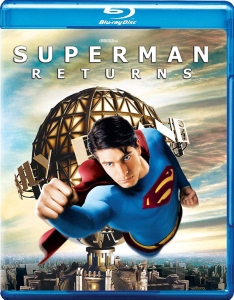After 19 years away from the big screen, ole Supes comes back in a weird way in “Superman Returns” (2006). Directed by “X-Men’s” Bryan Singer, a longtime fan of Richard Donner’s “Superman” (1978), this is a spiritual sequel to the original quadrilogy, but not a strict sequel. And that makes for a confusing viewing experience.
Skipping the backstory
A case could be make that this is a good way to reboot the saga. People are familiar with the Superman backstory, so it doesn’t need to be retold (similar to how the DCEU doesn’t retell Batman’s backstory in detail). And also, people want to see Clark and Lois in their prime, not two decades down the road. (Plus, Christopher Reeve sadly passed away in 2004 at age 52.)
However, it’s pretty unforgiveable that the filmmakers don’t explain the new timeline; we are left to scramble to catch up. In fact, they make matters worse by using the classic John Williams theme and opening credits font, plus clips of Jor-El’s (Marlon Brando) speeches from Donner’s films, making it seem like “Superman Returns” is a true sequel.

“Superman Returns” (2006)
Director: Bryan Singer
Writers: Michael Dougherty, Dan Harris, Bryan Singer
Stars: Brandon Routh, Kevin Spacey, Kate Bosworth
A 10-minute prologue, perhaps in place of the long opening credits, could have informed us of the details of this new timeline. (It also would’ve matched well with the original film’s brief voiceover introduction.) Without that, all viewers – both “Superman” die-hards and newbies – feel like they are watching a “part two” to a film that doesn’t exist.
The events of the first four films generally happened, but many (perhaps even all) of the specifics did not happen, and some of the rules of this timeline are different. For example, in the timeline of “Superman Returns”:
- Lois and Superman were intimate, but her memory was not erased. So she suspects Superman might be the father of her son.
- Clark’s mom is still alive.
- A trip to Krypton and back can be managed in five years, rather than thousands.
- Clark has a working space pod, either because his original one still works or because he constructed a new one.
- It’s 2006 (as is clear from the flat-screen TVs and flip phones), and Lois and Clark have not aged 19 years; if anything, they are younger than the last time we saw them. As such, their backstory happened at the turn of the 21st century rather than in the 1980s.
A mixed bag
I spent much of “Superman Returns” figuring out the events of the nonexistent “part one,” which is not a good way to watch a movie. For instance, when Lois talks about how Superman left without saying goodbye, I absorbed that as information about what happened in “part one,” rather than getting caught up in her emotions, which is what needs to happen in that scene.

Even for viewers who don’t give a lick about internal logic and want to appreciate “Superman Returns” as a singular piece of work, it’s a mixed bag.
On the upside, Singer and screenwriters Michael Dougherty and Dan Harris convey their love for this character in an expansive, artful fashion. After providing the requisite recording of the Williams score, composer John Ottman goes on to do more mythical and mystical work. This helps to convey the central theme that the world needs Superman (Brandon Routh) in a religious sense – not withstanding Lois’ (Kate Bosworth) bitter article in the wake of Supes’ departure to explore the ruins of Krypton.
Additionally, of course, humanity needs Superman as a practical matter to stop Lex Luthor (Kevin Spacey) from using kryptonian crystals to create a new continent in the Atlantic that will devastate the United States and kill billions. Spacey’s Luthor is a high point, and his plots are less G-rated here, starting with his affair with a dying woman, entirely a scheme to inherit her riches.
Uncomfortable leads
The main characters, as always, are Clark/Superman and Lois. But Routh and Bosworth aren’t Reeve and Kidder. They seem uncomfortable, like these are difficult jobs they have to get right so as not to disappoint anyone.
Bosworth is engaging in other things, such as “Blue Crush” and TV’s “Young Americans,” but we don’t get to know her version of Lois too well. Superman mostly broods about how Krypton is truly dead and how Lois and the world (in that order) don’t need him. (See Routh’s expression on the Blu-ray cover? That’s how he looks for most of the 2 1/2 hours.)
While there is an epic scope to “Superman Returns,” it leans toward the dour side. There is some humor, as with Luthor’s requisite abuse of his sidekick (in this case played by Parker Posey), but there’s not nearly as much of the “smile on your face” fun of the four Reeve films. I felt like I was dutifully admiring a piece of art in a gallery.
Beautiful special effects
In many categories, “Superman Returns” is better than its predecessors. The special effects are beautiful, and Singer is the most talented director to work on the franchise. In one of the few memorable moments between the leads, we see a close-up of Lois stepping onto Superman’s feet to prepare for their flight off the Daily Planet rooftop. Distracted by their conversation, we – and she – don’t realize they are flying until the camera pans away.
Because Lois is engaged to Richard (“X-Men’s” James Marsden) – who, to make matters worse, is an all-around great guy – this scene is steeped in melancholy. Lois and Superman love each other, but they can’t be together.
It’s a strong scene, in and of itself. But Lois and Clark – and “Superman Returns” as a whole — can’t shake its sense of malaise. There are great sequences, like when a Luthor henchman finds out the hard way that Lois’ kid has Superman genes. There are big, biblical events: Superman “dies,” but then lives. None of it makes the film uplifting, though. Even when we get to the requisite closing image of Superman soaring away to his theme song, I didn’t feel like “By golly, we DO need Superman.”

